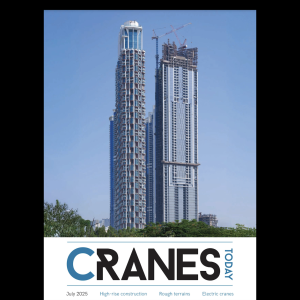
The 90t LRT LRT 1090-2.1 and the 100t LRT 1100-2.1 will be unveiled to the public at Conexpo in Las Vegas in March 2017.
The manufacturer offered rough terrain cranes in the 1980s to the mid-90s. The development of the new generation was preceded by extensive market surveys and analysis into the requirements for modern RT cranes, particularly in the main market of North America.
The two newly designed LRT cranes are based on the same basic technical concept. The crane chassis and turntable are almost identical. The differences relate to the boom length, telescoping technology, ballast weight and lifting capacity.
The LRT cranes measure 3.87m in height and 3.3m wide and are transported on public roads with a low loader. Their curb weight is less than 55t with complete equipment including ballast or under 40t without ballast and without equipment.
The 50m boom LRT 1100-2.1 has a “Telematik” telescoping system on which the various telescoping sections can be extended independently with a single cylinder and then pinned to the telescopic section above. Lifting capacities over the entire radius range can be achieved with just two telescoping modes, Strong or Long. 14t of counterweight ensure high stability. The lifting capacity of the LRT 1100-2.1 is around 15% higher than that of the 90t model which features 12t of counterweights.
The 47m LRT 1090-2.1’s telescoping system consists of a two-stage hydraulic cylinder with a rope extension mechanism. Like the 100t model the boom can be extended easily with two telescoping modes, Strong or Long.
A second winch and the rooster sheave are included as standard on the basic machine for two-hook operation. As an option a 10.5–19m double folding jib can be installed on the telescopic boom, at 0°, 20° or 40°.
Both cranes feature outrigger monitoring as standard. The support status, on tyres or outriggers, is detected automatically and saved to the crane controller. The attachment of the ballast to the turntable and the installation of the optional double folding jib including its angle adjustment are also recorded and monitored.
The VarioBase variable support base allows each outrigger to be extended to arbitrary lengths. Crane work is controlled by the load moment limiter within the LICCON controller.
The cabin is 220mm wider than other standard cabins on the market. It can be tilted backwards to provide greater comfort when hoisting loads to great heights. There are ladders, a large number of handles and an electrically extending platform on the cabin to ensure safe access to the crane.
The new LRT cranes feature a wide range of storage boxes for accessories, rigging equipment and support timber as standard. They also have a storage facility for the crane hook.
The two newly developed LRT crane models meet global safety standards and comply with all global regulations such as the US standard ANSI B30.5, The European EN 13000, Australian Standards (AS) and the Russian GOST standard.
Both crane models are powered by a Cummins diesel engine which meets all current emissions regulations. Their maximum speed is 25 km/h (15 mph). All-wheel and crab steering ensure easy handling and high manoeuvrability in constricted conditions.
The outrigger pads remain inside the width of the vehicle, and do not have to be removed for transport.






